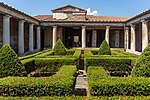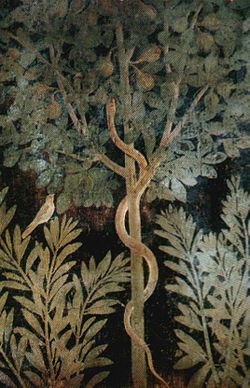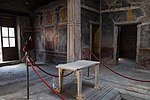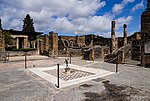Temple of Isis (Pompeii)

The Temple of Isis is a Roman temple dedicated to the Egyptian goddess Isis. This small and almost intact temple was one of the first discoveries during the excavation of Pompeii in 1764. Its role as a Hellenized Egyptian temple in a Roman colony was fully confirmed with an inscription detailed by Francisco la Vega on July 20, 1765. Original paintings and sculptures can be seen at the Museo Archaeologico in Naples; the site itself remains on the Via del Tempio di Iside. In the aftermath of the temple's discovery many well-known artists and illustrators swarmed to the site.The preserved Pompeian temple is actually the second structure; the original building built during the reign of Augustus was damaged in an earlier earthquake, in 62 AD. Previously to this, in both 54 BCE and 30 BCE, the Roman senate had issued proclamations demanding that the cult of Isis and her temples be demolished. It is reported that there were no volunteers to undertake this process, and that the cult only grew in popularity from this point, so much so that the Temple of Isis was one of the only buildings to be fully rebuilt after the earthquake. At the time of the 79 AD eruption of Vesuvius, the Iseum was the only temple to have been completely re-built; even the Capitolium had not been. Although the Iseum was wedged into a small and narrow space, it received significant foot traffic from theater-goers at the Large Theater, businessmen in the Triangular Forum, and others along the Stabian Gate. Principal devotees of this temple are assumed to be women, freedmen, and slaves. Initiates of the Isis mystery cult worshipped a compassionate goddess who promised eventual salvation and a perpetual relationship throughout life and after death. The temple itself was reconstructed in honor of a 6-year-old boy named Numerius Popidius Celsinus by his freedman father, Numerius Popidius Ampliatus, and his mother Corelia Celsa, to allow the child to enter elite society. Many scenes from the temple are re-created in the dining rooms of Pompeians, however, indicating that many individuals visited this temple for political, economic, or social reasons.
Excerpt from the Wikipedia article Temple of Isis (Pompeii) (License: CC BY-SA 3.0, Authors, Images).Temple of Isis (Pompeii)
Via del Tempio d'Iside,
Geographical coordinates (GPS) Address Website External links Nearby Places Show on map
Geographical coordinates (GPS)
| Latitude | Longitude |
|---|---|
| N 40.749166666667 ° | E 14.488277777778 ° |
Address
Tempio d'Iside
Via del Tempio d'Iside
80045
Campania, Italy
Open on Google Maps











